In today's digital age, the smoke of war on the business battlefield has never been so intense. As the dividends of the Internet gradually fade, the cost of public domain traffic is rising, and the competition among enterprises for limited user resources has entered a fierce stage. Behind every click and every exposure is a high price that companies have to bear. Against this background, the traditional model of relying on public traffic to acquire new customers is facing unprecedented challenges, forcing companies to re-examine their marketing strategies and explore more cost-effective and sustainable ways to build customer relationships.
Therefore, effectively converting public domain traffic into private domain traffic and building their own user pool has become an inevitable choice for many enterprises to break through the siege and seek new growth points in the fierce competition. This is not only a proactive adaptation to changes in the market environment, but also a core strategy for companies to deepen user understanding, enhance customer lifetime value, and strengthen brand loyalty.
In previous articles, we have made a special introduction to the APMDR model , but this model did not focus on the operation of private domain traffic. In this article, we will delve into a life cycle model that is more frequently used in private domain traffic scenarios - the AIPL model . By adopting this user life cycle management model, enterprises can convert public domain traffic into private domain traffic more efficiently. Thereby enhancing market competitiveness.
What is the AIPL model?
The AIPL model is a user life cycle management model commonly used in the field of digital marketing . Its full name is Awareness, Interest, Purchase and Loyalty. This model is used to help companies deeply analyze and effectively manage the entire life cycle of users from first contact with the brand, through awareness, interest, purchase, and finally becoming loyal fans.

● Awareness
This is the first step in the user journey and the goal is to get potential customers to recognize and notice the brand for the first time. At this stage, companies increase brand awareness through advertising, social media, content marketing and other means to let users know the existence of the brand and the value it can provide.
● Interest
After users have a preliminary understanding of the brand, the next step is to stimulate their interest. By providing valuable content, product information, trial experiences or interactive activities, users can gain in-depth understanding of the brand and products, turning them from bystanders to active participants.
● Purchase
On the basis of the interest stage, companies encourage users to complete their first purchase through strategies such as promotions, coupons, and personalized recommendations. This stage is a key step in realizing user value, marking the transition from potential customers to actual consumers.
● Loyalty
Post-purchase user management is particularly important. The goal is to enhance user satisfaction and loyalty through high-quality customer service, after-sales support, membership programs, personalized experiences, etc., prompting them to make repeat purchases and potentially become brand advocates through Word-of-mouth recommendations drive the growth of new users.
Implement the AIPL model in the customer data insight platform
After understanding the stage division of the AIPL model and user positioning at different stages, we will take users shopping in a certain e-commerce brand mini-program as an example to introduce the application of the AIPL model in business and its use in the Kangaroo Cloud customer data insight platform . of landing.
Business scenario preparation
In the mini program brand shopping scenario, the representative behaviors of each stage of the user life cycle can be summarized as follows:
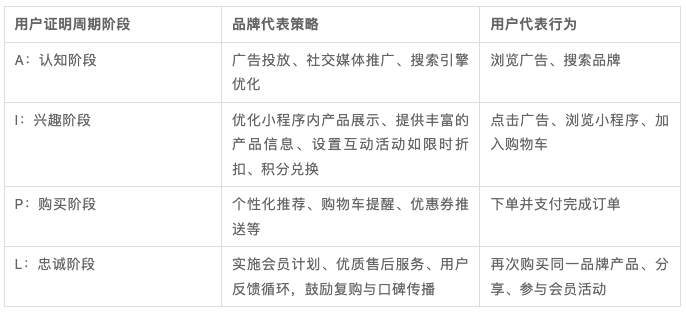
Based on the above scenario, it is necessary to establish the following label system for users and generate a model:

Each user will only have one life cycle stage in the current stage. When multiple conditions are met at the same time, the user is considered to be in a subsequent life cycle stage. That is: if the user meets the conditions of A, I, and P at the same time, the user is currently in the P stage of the life cycle.
Configure the AIPL model in the customer data insight platform
After the business definition is determined, the required tags in the definition can be configured and published in the " Customer Data Insight Platform ". Tag configuration logic has been discussed in previous articles, so I won’t go into details here. Interested friends can read the previous articles to learn more: Theory + Practical Operation | Master the implementation of RFM model in the customer data insight platform in one article
After preparing the basic data, you can go to the " Customer Model " module to configure and apply the AIPL model .
● Step 1: Create AIPL model
The platform has a built-in customer value model and three life cycle models . According to our current needs, we choose the AIPL model among the life cycle models.
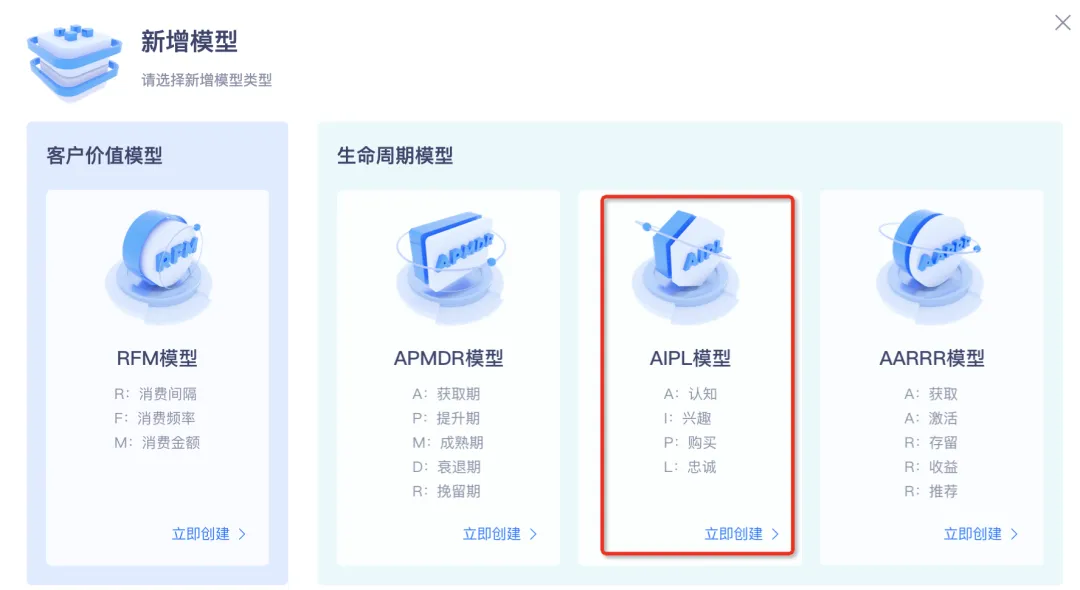
● Step 2: Configure model rules based on previously defined stage conditions
· Definition of cognitive stage rules

· Interest stage rule definition

· Definition of purchasing stage rules

· Definition of loyalty stage rules
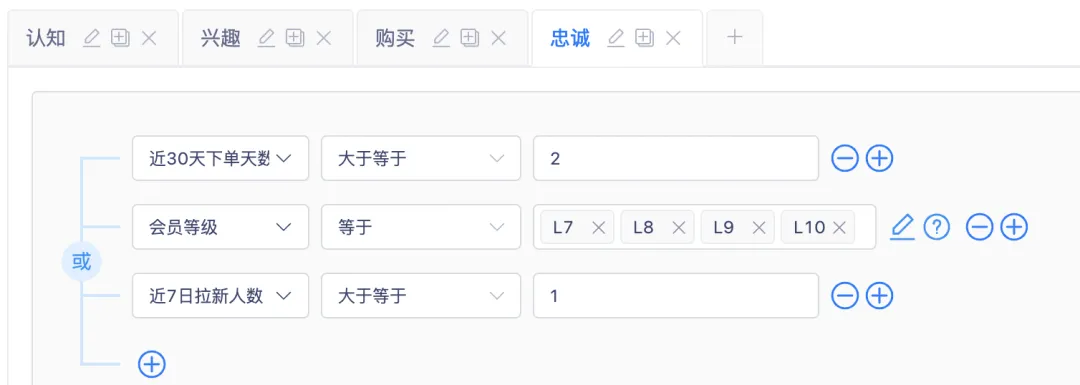
After the configuration is completed, the crowd coverage at each stage can be precalculated through the " Estimated Number of People " function.
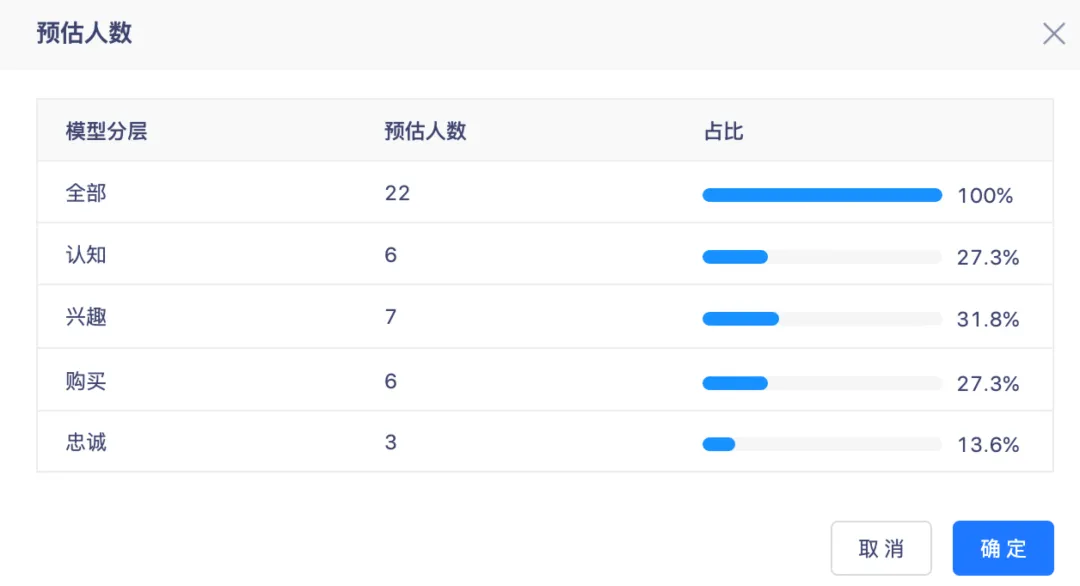
● Step 3: Update model data to facilitate subsequent model analysis
After creating a model and generating model data , you can regularly track the distribution of users at each stage.
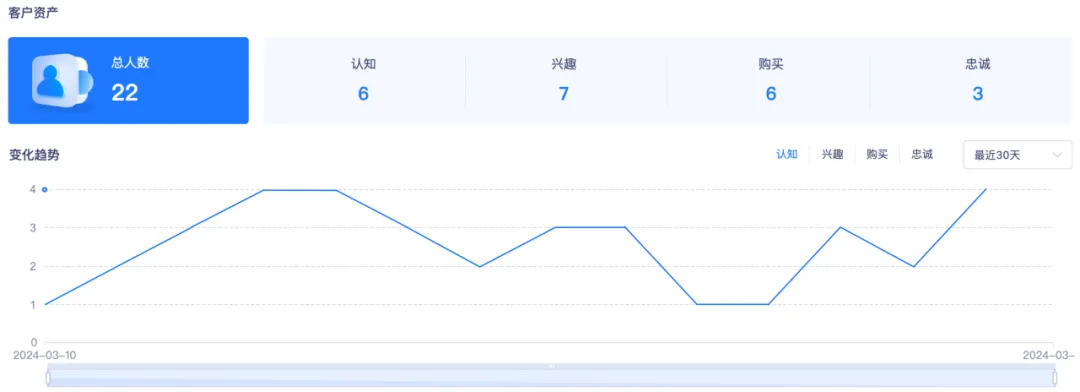
In addition, you can specify two specific days to view changes in user stages during this period.

For example, from the data flow in the figure below, we can see that on April 24, 3 customers flowed from the awareness stage to the interest stage; 4 customers flowed from the interest stage to the purchase stage; there were 1 customer in the awareness stage and 1 customer in the purchase stage respectively. The users in the loyalty stage flowed into the loyalty stage, and the number of incoming customers increased by 133%.
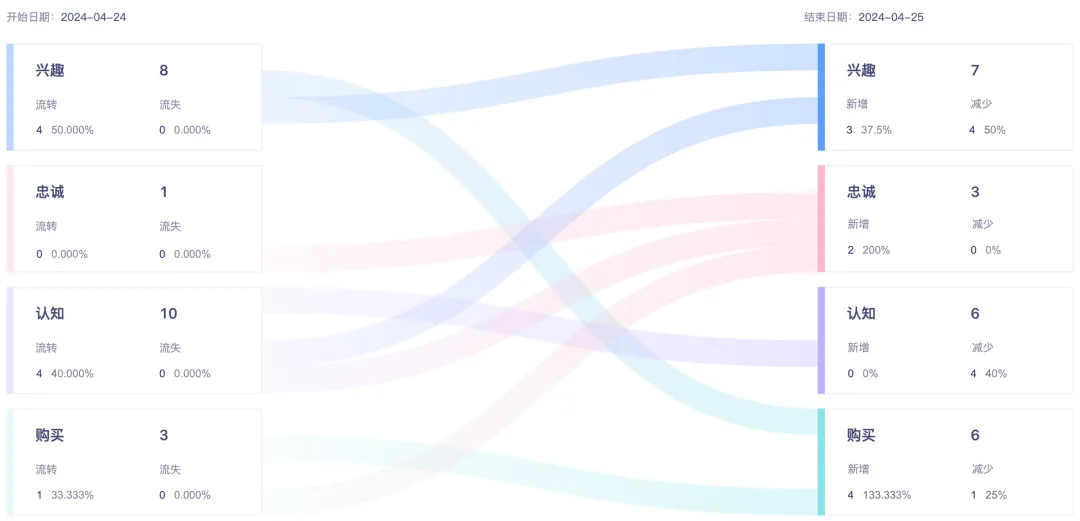
Based on this data, the particularity of this batch of user inflows can be further analyzed to explore marketing strategies and improve the willingness and speed of transfer of other customers. It can be seen from the figure that there is currently no user churn, which is a good performance.
Summarize
For enterprises and marketers, using the AIPL model to divide users into stages can help them fully understand the entire process of users from initial contact to becoming loyal customers, making the formulation of marketing strategies more scientific and systematic.
The implementation of user stage classification and data tracking into the " Customer Data Insight Platform " provides enterprises with decision-making basis supported by data, helps optimize marketing activities, reduces blindness, and improves the scientificity and accuracy of decision-making. At the same time, real-time tracking based on data enables the quantification of brand crowd assets, making it easier to track the effectiveness of marketing activities, evaluate user conversion rates at different stages, adjust strategies in a timely manner, and optimize overall marketing performance.
Through the " Customer Data Insight Platform ", timely tracking of the user life cycle and its value can further achieve refined operations at each stage, extend the user life cycle, increase the user's value contribution, increase user repurchase rate and word-of-mouth communication, and ultimately Maximize user lifetime value (CLV).
"Industry Indicator System White Paper" download address: https://www.dtstack.com/resources/1057?src=szsm
"Dutstack Product White Paper" download address: https://www.dtstack.com/resources/1004?src=szsm
"Data Governance Industry Practice White Paper" download address: https://www.dtstack.com/resources/1001?src=szsm
For those who want to know or consult more about big data products, industry solutions, and customer cases, visit the Kangaroo Cloud official website: https://www.dtstack.com/?src=szkyzg
The pirated resources of "Celebrating More Than Years 2" were uploaded to npm, causing npmmirror to have to suspend the unpkg service. Microsoft's China AI team collectively packed up and went to the United States, involving hundreds of people. The founder of the first front-end visualization library and Baidu's well-known open source project ECharts - "going to the sea" to support Fish scammers used TeamViewer to transfer 3.98 million! What should remote desktop vendors do? Zhou Hongyi: There is not much time left for Google. It is recommended that all products be open source. A former employee of a well-known open source company broke the news: After being challenged by his subordinates, the technical leader became furious and fired the pregnant female employee. Google showed how to run ChromeOS in an Android virtual machine. Please give me some advice. , what role does time.sleep(6) here play? Microsoft responds to rumors that China's AI team is "packing for the United States" People's Daily Online comments on office software's matryoshka-like charging: Only by actively solving "sets" can we have a future